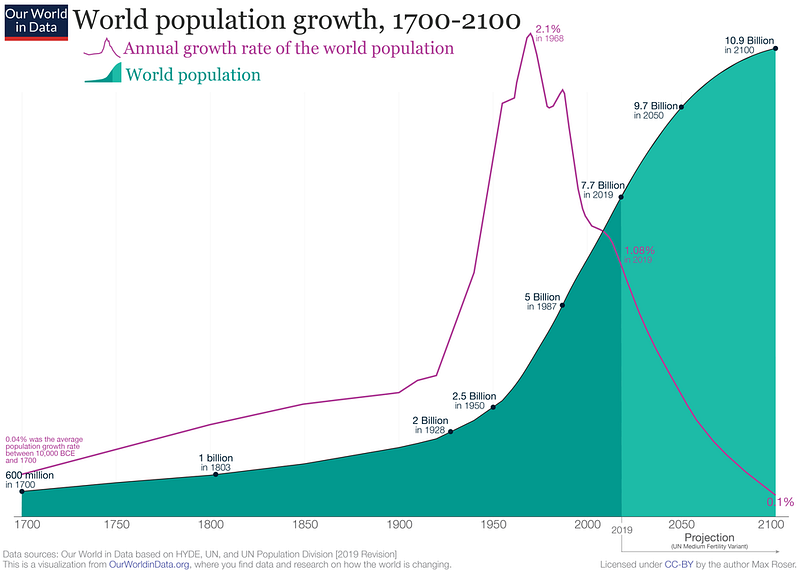Understanding the Global Population Surge: Insights and Implications
Written on
Chapter 1: The Significance of November 15
What makes November 15 noteworthy?

Image by Gerd Altmann from Pixabay (modified by author)
In my prior discussion on the escalating global population, I elaborated on the dual nature of this increase: while the total numbers are rising, the rate of growth is concurrently slowing.
Is Overpopulation Still a Significant Concern?
Let’s delve into the statistics.
As mentioned earlier, the primary contributors to global population growth are Africa and India. Most other regions have either plateaued or are experiencing negligible increases that hardly impact global figures.
Why mark November 15?
On this date, we will either hit or have already reached a remarkable milestone: a total of 8 billion people. While the precise timing remains uncertain, UN forecasts indicate that this is the day we officially become 8 billion strong.
The Case of India
In 2023, another milestone will occur: India is set to overtake China as the most populous nation. Currently, India is only slightly behind China, yet they account for 86,000 births daily, compared to China's 49,400.
China peaked at 1.43 billion in 2021 and is expected to maintain this number until 2024, after which a decline will begin:

Credit: OurWorldInData.org/future-population-growth • CC BY (modified by author)
India's population is projected to peak at 1.70 billion by 2060, before gradually decreasing to 1.53 billion by 2100. In contrast, China's population is expected to drop to 766 million by the same year.
In 1960, India recorded an average of 6 births per woman, which decreased to 2.18 by 2020. Although this represents a significant reduction, it remains insufficient to prevent an increase of nearly 300 million people by 2060, primarily due to the large base population and improved life expectancy.
China's Fertility Challenges
China currently reports a fertility rate of 1.70 births per woman, a figure that is anticipated to decline further. Consequently, their population is expected to experience a steep decline by the century's end, paralleling the fertility situation Japan faced in the 1980s.
Annual Population Growth vs. Growth Rate
Despite the projected global population reaching approximately 11 billion by 2100, the annual growth rate has been decreasing since 1968:

Credit: Max Roser, CC BY-SA 4.0
In 1968, the world population was around 3.5 billion, coinciding with a peak annual growth rate of 2.1%, which surged following the 1920s and the conclusion of World War I. Although projections show the global population reaching 10.9 billion by 2100, the annual growth rate is expected to dwindle to just 0.1%. This rate barely exceeds the historical average growth rate of 0.04% recorded between 10,000 BCE and 1700.
The graph may appear counterintuitive at first glance, but it highlights that as the population increases, even with falling growth rates, the absolute number of new births rises. For instance, a 0.1% growth rate at a population of 1 billion yields an addition of 1 million people per year, whereas at 10 billion, it results in 10 million.
Only when the annual growth rate stabilizes at zero or turns negative will the global population begin to decrease, a scenario projected to unfold in the early decades of the 22nd century, assuming humanity persists that long.
Rising Immigration Trends
The stark demographic disparities between rapidly aging nations with low fertility rates and the soaring populations in regions like Africa (where Niger currently averages 7 births per woman) and India suggest that substantial immigration will persist until at least mid-century.
Even if individuals from developing nations lose interest in relocating, developed countries may find it necessary to invite them through various incentives. Without this influx, their pension systems, tax revenues, and overall economic stability could be jeopardized.
Concluding Thoughts
In essence, Africa and India will continue to have a surplus of labor, while many other regions are facing an acute manpower shortage that is worsening rapidly. With fewer individuals supporting a growing number of retirees, a dwindling consumer base, and fewer taxpayers, the implications are significant.
Ignoring the complexities in favor of short-sighted political agendas—such as those that led to the UK's exit from the EU—will not alter this reality. For example, Japan has employed various strategies to encourage births, yet none have proven effective.
In summary, the dynamics of global population growth are intricately more nuanced than sensational headlines like "The Earth’s population will explode!!" or "Can the Earth sustain us all?" Such statements may capture attention but fail to convey the entire picture.
That concludes this exploration, and I have provided sources below as per academic standards. Additionally, I recommend this intriguing article by Matt Patton, which, while unrelated to my topic, I found insightful:
The Parable of the Fly: You Only Get So Many Chances
When your window of opportunity opens, will you notice it?

The first video highlights the iconic phrase "Remember the 5th of November" and delves into its historical significance.
The second video presents a traditional English rhyme associated with the 5th of November, enriching our understanding of this date's cultural relevance.
Sources:
- World Population Growth | Our World in Data
- India will soon overtake China to become the most populous country in the world | Our World in Data
- India faces deepening demographic divide as it prepares to overtake China as the world’s most populous country | The Guardian